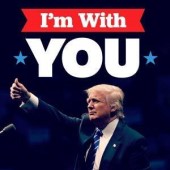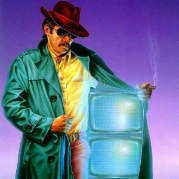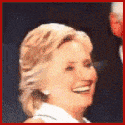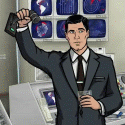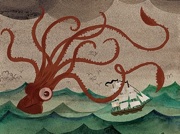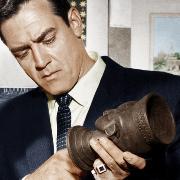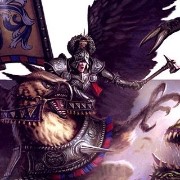|
 The Telegraph, “Making a murderer: did the CIA’s secret LSD labs turn Charles Manson into a Killer?”, By Tom O’Neill, with Dan Piepenbring, July 31st, 2019 posted:I’d always believed that Cold War-era paranoia had overstated the potential for brainwashing. Now, with Alan Scheflin, a forensic psychologist and law professor who’d written a book on MKULTRA, I had to ask if it possible that the Manson murders were an MKULTRA experiment gone wrong. “No,” Scheflin said. “An MKULTRA experiment gone right.” * Hello CSPAM. This is a thread about the book Chaos: Charles Manson, the CIA and the Secret History of the Sixties by Tom O’Neill (with Dan Piepenbring). The book never quite achieves its promise of being a “Secret History of the Sixties” but the narrative does sprawl across numerous lurid and interesting topics that and hints toward hidden events and untold stories that would upend the common understanding of that decade and the social forces within it. The book is an enjoyable and easy read that doesn’t try to disguise or tidy up the messy and at times almost incoherent nature of the subject matter. Instead of trying to offer a panoptic birds-eye view of the situation Tom O’Neill is candid about the long and difficult process behind the creation of this book. What was supposed to be a magazine article published in 1999 became a 20 year project that consumed the author's life. The fact this book is speculative, open ended and messy should lend itself to more interesting discussion. Because the narrative itself is only half formed I hope everyone will feel less intimidated about sharing thoughts and opinions. This is also an interesting look at ‘how the sausage is made’ that is unusually candid about the process through which a bunch of random hard to explain facts become assembled into a narrative form. A slicker, more put together book hides this process but here we get to see it playing out. Various facts about the case are uncovered and discussed. After clear evidence that the official story is a lie emerges the author comes across a number of increasingly strange possible explanations. O’Neill clearly changes his own mind back and forth over time and remains cagey about his own theories at the end of the book. At times this book feels like the author took three different puzzles, mixed the pieces together and then dumped them on the floor in front of you and then invited you to take your best shot at creating a coherent image. Nevertheless… There is a lot of interesting original reporting and research in here, some of which has never come to light before. Manson’s bizarre relationship with authorities is detailed; he was able to skip parole with impunity, had a bizarrely close relationship with one of his parole officers and hung around a clinic in Haight Ashbury that was simultaneously being used by CIA funded researchers involved in the MK ULTRA program. Multiple police and prosecutor cover ups are convincingly documented. An additional likely murder by the Manson family gets reclassified as a suicide despite the coroners reservations. Various seemingly unrelated incidents suddenly become implicated - even the JFK assassination gets pulled into the mix eventually. O’Neill does a good job of tracking down people who participated in these events. Rather than just relying on documentary evidence and freedom of information requests he actually did a lot of old school shoe leather reporting and it really pays off here. Notwithstanding my comments on the books speculative and unfinished nature, this is an extremely impressive work of reporting. Modern journalists simply do not have the money or inclination to pursue stories this doggedly and for this long and for that alone O’Neill’s book deserves some recognition. Plan for the Thread My hope is that this thread will serve as both as a place for anyone who has read or is reading the book to discuss it section by section. I will be posting excerpts and summaries from the chapters so that anyone reading this thread will be able to follow the narrative. I hope that discussions about the book will encourage people to bring in additional topics of discussion or to reference other books, films, articles, etc. as appropriate. This book covers a lot of ground and I hope the thread can be equally wide ranging. After making this initial post I will give people a bit of time to look into acquiring the book for themselves if they are so inclined. Then I will start moving section by section through the books contents and will try to adjust the thread based on the level of interest and engagement my posts create. I am also hoping to make periodic posts about topics that are touched on by this book or by the discussions it triggers. Instead of narrowly confining ourselves to a discussion of the book I invite people to discuss other topics that are relevant to a “secret history” of the 1960s and 70s. The public perception of the hippie movement, the changing culture of Hollywood celebrity, the rise of Nixon’s “silent majority” backlash politics, the assassination of John F. Kennedy, the covert programs run by the CIA and their uncovering by congressional inquiries decades later. As far as I’m concerned all of this and much more is fair game and all of it can be fruitfully tied back to the events in this book. As a final note: I strongly encourage folks to buy this book. This kind of reporting is very rare and the author deserves compensation for the years of hard work they invested in this story. If you have the resources please consider supporting Tom O’Neill. That having been said, if anyone is completely unable to afford the book and doesn’t live anywhere near a public library but really want to participate fully here then I should be able to advise you on how to acquire it so don’t hesitate to reach out. Further Resources --Where to purchase the book --An interview with author Tom O'Neill on Chaps Trap House --A wide ranging discussion of the events covered in the book between O'Neill and host at the Los Angeles Press Club.
|
|
|
|

|
| # ? May 5, 2024 00:20 |
|
Use this post to quickly navigate the thread. As each chapter gets covered I will convert it into a link to the relevant part of the thread. -Prologue -Chapter 1. The Crime of the Century -Chapter 2. An Aura of Danger -Chapter 3. The Golden Penetrators -Chapter 4. The Holes in Helter Skelter -Chapter 5. Amnesia at the L.A. County Sheriff's Office -Chapter 6. "Who Was Reeve Whitson?" -Chapter 7. "Neutralizing the Left" -Chapter 8. The Lawyer Swap -Chapter 9. Manson's Get-Out-of-Jail-Free Card -Chapter 10. The Haight-Ashbury Free Medical Clinic -Chapter 11. Mind Control -Chapter 12. Where Does It All Go? -Epilogue Helsing has issued a correction as of 17:45 on Feb 22, 2020 |
|
|
|
 From time to time I've posted articles or excerpts from books that discuss or expand upon some of the themes covered in this thread. I'll post them here. -LA Times: The Secret Society Among Lawmen -BBC News: Pont-Saint-Esprit poisoning: Did the CIA spread LSD? -Washington Post: CIA may have used contractor who inspired ‘Mission: Impossible’ to kill RFK, new book alleges -Associated Press: After learning of Whitey Bulger LSD tests, juror has regrets Helsing has issued a correction as of 14:29 on Aug 22, 2020 |
|
|
|
hell yes, at last
|
|
|
|
Present
|
|
|
|
ooooh the 60's, might even get a hardcover!
|
|
|
|
Looks interesting!
|
|
|
|
Yesss
|
|
|
|
it might be worth at least skimming some takes on stuff like weird scenes inside the canyon for further info on the late 60s counterculture scene and paranoiac vibe particularly in cali. and maybe have a listen to the manson series of you must remember this pod, for the more widely accepted account of the story. useful to compare and contrast, it's a worthwhile engaging listen even if o'neill's research calls much of longworth's series into question. https://castbox.fm/vb/177198426
|
|
|
|
Dammit, Montreal libraries only have 1 copy of the book and it's already reserved. Might have to
|
|
|
|
whats everyones unified theory obviously over arching the cia et al. wanted to smash sympathy for the left, but to what extent were they also experimenting on human subjects with mind control n poo poo?? Reeve Whitson is brad pitt and once upon a time in hollywood is full of clues!!! also in the irishman when al pacino says "they can give anyone a heart attack!!!" he's talking about kubrick. but How does the holodomor tie in? I am starting my own bellingcat except anti-nato. If anyone wants to be a senior reserach fellow, I ask you start here https://en.wikipedia.org/wiki/Category:Central_Intelligence_Agency_front_organizations https://www.nimh.nih.gov/index.shtml https://en.wikipedia.org/wiki/Montreal_experiments
|
|
|
|
hell yeah
|
|
|
|
Also an interview on night call.
|
|
|
|
A neat thing I learned while listening to chapo trap house interview with the author is that roman polanski wasn't at home with sharon tate the night she was murdered because he was scouting locations for a movie he was planning on directing, The Day of the Dolphin, a movie based on entirely different government LSD experiments (The navy paid a guy to give acid to dolphins and make them have sex with women so they could learn to speak english and teach the human race how to communicate with aliens)
|
|
|
|
and also that scientist made contact with the machine mind and was also a pedophile
|
|
|
|
thanks for making the thread OP. i own the book, but haven't started it yet. will do so and post updates
|
|
|
|
Dr. Killjoy posted:and also that scientist made contact with the machine mind go on Also John C Lily (the scientist) references are also intentionally placed all over the dark, sadistic, impossible Sega game Ecco the Dolphin
|
|
|
|
i feel so bad for sharon, everyone treated her like complete poo poo. that stuff about the movies the cops found in the loft...
|
|
|
|
Following. This has the potential to go places.
|
|
|
|
I'm glad to see there is so much interest! I am going to give folks the rest of the weekend to get their hands on the book and to start reading it and then we'll get started with the lets read. The thread will be set up so that someone should be able to enjoy it even if they don't have time to read the book themselves but obviously the more people who are reading this together the better. Also please note that I'll try to update the OP with links to important posts in the thread, so people can use the OP to navigate the thread as time goes on. In the meantime I will make a short post summarizing who Manson was and giving some contextualizing details. I was thinking of also doing a post on MK-ULTRA and Operation CHAOS but I decided it would be better to follow the path of the book, which initially focuses on other leads, so we'll leave the spooky clandestine stuff on the side for now.
|
|
|
|
Man, I was just listening to the audiobook after hearing the Chapo interview and seeing Once Upon a Time in America later on. Still haven’t finished it, have just started into the “hey, maybe the CIA and the FBI might have something to do with this?” part of the book, but should be interesting revisiting and studying previous parts further with everyone.
|
|
|
|
So, I was aware of this book back when the promotional tour was happening, iirc, and i was fascinated at it. But this thread prompted me to drop an Audible credit on the book and holy poo poo. So far, with what i've heard, I'm leaning towards the CIA/LAPD knowing about Manson and just letting him do his thing, encouraging it in all likelihood, and when he acted they used it as a big set-piece Hippy Killer event. It's in line with what Nixon was doing with the war on drugs, per this: quote:"The Nixon campaign in 1968, and the Nixon White House after that, had two enemies: the antiwar left and black people,"... [...] ..."You understand what I'm saying? We knew we couldn't make it illegal to be either against the war or black, but by getting the public to associate the hippies with marijuana and blacks with heroin. And then criminalizing both heavily, we could disrupt those communities," Ehrlichman said. "We could arrest their leaders. raid their homes, break up their meetings, and vilify them night after night on the evening news. Did we know we were lying about the drugs? Of course we did." I think they were basically hands-off grooming people that fit that hippie archetype for violence so they could go on to discredit the whole movement. if you're looking for unstable easily manipulated people, you can find them, and it's probably not very hard to break their brains. The extent to which Manson was a willing participant, and to which the murders were planned, it's pretty obvious they were just trying to generate opportunities to then capitalize on, in my mind. If you do it like this, unless you've got like tape and paperwork proving it happened, you really can't know, you can't assign firm blame, you firmly place what you're doing in a cloud of uncertainty, so even if people grasp a detail here or there, there will never be enough that you can go to the public and convince them that because of this stuff, they need to be destroyed. it's absolutely in line with what intelligence agencies were doing back then. But I have more book to read, so this first impression is probably gonna be blown away by whatever soon. This is Crack, Ping! the book and I dig it.
|
|
|
|
|
Thank you Riot Bimbo, that is the perfect set up for this post I wanted to make on the context in which the events of this book take place. I apologize for anyone who finds this redundant but before proceeding to the Let's Read I want to give everyone some background info before we proceed to the book. I will have the first part of the actual Let’s Read ready soon. Before then let’s recap who Manson and his “family” were and the impact they had on the cultural history of America. As the thread moves on we’ll increasingly get into the clandestine crack ping stuff but first let's get the conventional narrative and its understood role in history clear so that we’re all on the same page. Manson is of course known for the string of brutal home invasions/murders perpetrated by his followers. These killings (the ones he was charged with, as there were almost certainly others) were spread across two attacks against seemingly unrelated targets. In the first attack, a group of Manson’s followers descended upon a house in Beverly Hills on the night of August 8th, 1969, and murdered the four people they found there, among them actress Sharon Tate. On August 10th they struck again, killing Leno and Rosemary Bianca. Initially authorities did not connect these seemingly random killings but later they would become known as the Tate-LaBianca murders. That’s typically how they’ll be referred to throughout the book. In December 1969 five individuals were arrested in connection with the case. Shortly thereafter the public first learned the name Charles Manson. The killers were said to be part of a hippie commune. Composed largely of young women, many of whom had run away from middle class backgrounds, the group sustained itself by stealing and selling cars and imbibed massive quantities of LSD. Historian Rick Perlstein, writing in the must read book “Nixonland”, offers the following scene setting description of press reaction to Manson: Nixonland: The Rise of a President and the Fracturing of America, Rick Perlstein, p 443-444 posted:The murderers, allegedly, were a “nomadic band of hippies,” the New York Times reported, led by a thirty-four-year-old guru, Charles Manson, who had picked them up cruising Haight-Ashbury during that 1967 Summer of Love. Four other members of the “Manson Family” were implicated in three other murders. “He played the guitar, he sang,” an outsider to the group observed. “He preached love and peace and all that.” A female member of the cult—he called them his “slaves”; they referred to him as “God” and “Satan”—explained his appeal: “You’re brought up to believe that you can’t have sex unless you’re married. Here girls could do whatever they wanted.” The Times’s California correspondant Steve Roberts now reported the victims had been preyed upon by a hippie gang who “lived a life of indolence, free sex, midnight motorcycle races, and apparently blind obedience to a mysterious guru,” and recast the Tate-Polanskis as almost just another affluent suburban couple. The December 19 Life, above a picture of a wild-eyed Manson, called it “The Love and Terror Cult.” “Could Your Daughter Kill?” asked Los Angeles magazine. During his trial Manson appeared in court with an “X” carved into his forehead and declared that he had “X’d” himself from society. Several of his followers and three of his co-defendants emulated him and similarly appeared in court with bloody X marks on their foreheads. Manson and his co defendants interrupted court proceedings. His followers were exiled from the courtroom and camped out around the block, sometimes threatening to immolate themselves like Vietnamese monks.  Among Manson’s prosecutors was one Vincent Bugliosi, a man who will feature prominently in Chaos, serving as the books primary antagonist. Bugliosi went on to publish a book called “Helter Skelter” that remains the best selling crime book of all time and which remains the most influential interpretation of the case: specifically, that Manson’s followers staged the murders with the intentions of starting an apocalyptic race war. Accounts like this one contributed to a broader anxiety about the breakdown of American culture and the idea that the rapid cultural changes of the era were leading toward a bloodbath. Beneath the flower power rhetoric seemed to lurk something that was not only anti-American but perhaps literally Satanic. This would have political implications that reverberate down to the present day. In 1964 Lyndon B. Johnson had won a resounding victory against arch conservative Republican presidential candidate Barry Goldwater. Goldwater’s followers had seized control of the GOP and transformed it into a vehicle for conservative opposition to the New Deal and Civil Rights. They had run on a right wing platform that presented a sharp contrast with the big government liberalism of the Kennedy-Johnson administration and now it seemed clear to everyone that conservatism was dead on arrival. The American people had spoken. Less than a decade later Richard Nixon would sweep into power riding a middle American backlash against the counterculture. Though it was Reagan who would perfect this ‘southern strategy’ it was Nixon who pioneered it with his calls for ‘law and order’ and his promise to be the President of the “silent majority” of patriotic and law abiding Americans. Many of the tropes and obsessions that have marked the culture war ever since would be formed in this hinge period between the late 1960s and the mid 1970s. Most of that is beyond the scope of this thread but you should hold that context in mind as we proceed with this book. Both neoliberalism and neoconservatism were heavily shaped by the cultural and economic anxieties of this period. In some very crucial ways the DNA of the modern conservative and liberal factions of American politics was formed out of the events of this period. I’ve also described this at length because I think it's important for people to understand the sense of momentous change that everyone in this era shared. Whether you were a radical eagerly anticipating the imminent revolution or a conservative terrified of the encroaching social chaos there was a widely shared perception that something was coming to a head and that some transformative event was just around the corner. Understanding that mindset may help you understand some of the otherwise very strange decisions taken by the authorities later in this book. Indeed, as we will see once we start going through the book the US government was extremely concerned about and eager to study and monitor the various movements and subcultures that were rising to prominence in the 1960s. Hunter S. Thompson, reminiscing over the feverish expectations and ultiamte dissapointment of Calfornia in teh 1960s, captures this vibe really well in Fear and Loathing in Los Vegas when he writes. Notably, this passage immediately follows Thompson's discussion of experimenting with LSD, a drug that features prominently the Manson case: Fear and Loathing in Los Vegas, Hunter S. Thompson, p. 66-67 posted:Strange memories on this nervous night in Las Vegas. Five years later? Six? It seems like a lifetime, or at least a Main Era—the kind of peak that never comes again. San Francisco in the middle sixties was a very special time and place to be a part of. Maybe it meant something. Maybe not, in the long run . . . but no explanation, no mix of words or music or memories can touch that sense of knowing that you were there and alive in that corner of time and the world. Whatever it meant. . . .
|
|
|
|
Well that sure has some parallels to today! In suspense, looking forward to more!
|
|
|
|
turns out my local library has this thing! picking it up today
|
|
|
|
Bought a copy that was delivered today. I'm not sure when I'll have a chance to actually read it since I'm taking a full class load in addition to working full time but I'm looking forward to it when I do have the time!
|
|
|
|
Algund Eenboom posted:(The navy paid a guy to give acid to dolphins and make them have sex with women so they could learn to speak english and teach the human race how to communicate with aliens) god drat lmao
|
|
|
|
Anybody here ever read Peter Levenda's Sinister Forces trilogy?
|
|
|
|
Cheers Helsing. Got my copy just in time for the thread. Haven't cracked it open yet, excited for this.
|
|
|
|
PROLOGUE Alright it’s finally here, the first section. I am honestly not sure what the best way to do this is or how detailed I should be in my summaries so any feedback will be helpful. Ideally I’d like to do this so that someone who can’t access the book is able to follow along without making the thread tedious. I also encourage people to talk about whatever parts of the book interest them. If you wanna jump ahead go for it, or if you wanna pull in additional topics feel free. So here we are at the prologue. This section is clearly written as a hook to catch the readers attention as we’re tossed into the middle of a contentious argument between O’Neill and Vincent Bugliosi, the retired prosecutor and true crime author who put Manson behind bars and then authorized the best selling book ‘Helter Skelter’ that cemented Manson’s image in the public eye. The book begins: quote:Vincent Bugliosi was on another tirade. O’Neill sets the scene, describing how Vince (O’Neill tells us: “I was on a first-name basis with him, as I guess adversaries must be”) “was a master orator” who, despite being retired and 71 years old, could still hold court over his kitchen table. We learn how this is not their first meeting and how on this particular occasion they argue back and forth for more than six hours, with Bugliosi doing most of the talking. Both men have multiple tape recorders running and Bugliosi’ wife is on hand as well. O’Neill then explains their point of contention: quote:Bugliosi had made his name with the Manson trial, captivating the nation O’Neill, by his own account, is “a bundle of nerves”: “I’m not a churchgoing person, but I’d gone to church that morning and said a little prayer… I hoped that my interview with Vince would mark a turning point in my seven years of intensive reporting on the Manson murders.” By this point O’Neill says his investigation has left him “at various points, broke, depressed, and terrified that I was becoming one of “those people”: an obsessive, a conspiracy theorist, a lunatic. I’d let friendships fall away. My family ahd worried about my sanity.” He continues: quote:I don’t consider myself credulous, but I’d discovered things I thought The hope for O’Neill is that after meticulous preparation and with his extensive notes, maybe “If I could get Bugliosi to admit any wrongdoing, or even to let a stray detail slip, I could finally start to unravel dozens of the other strands of my reporting. Maybe soon I could get my life back, whatever that might look like.” But as the hours pass and Bugliosi continues to take up most of the air time O’Neill realizes he’s been stone walled and that the veteran prosecutor has a ready answer for everything thrown at him. Still, Bugliosi does acknowledge that O’Neill has found something intriguing: quote:“It’s a tribute to your research,” he told me. “You found something that I O’Neill is heartened to see he has gotten under Bugliosi’ skin. The ex prosecutor is clearly bothered by this possible threat to his legacy. quote:Another one of my sources had tipped off Vince about my reporting, The meeting ends without a real climax, and Bugliosi tries both threatening and enticing O’Neill, on the one hand saying ““If you do the book and it’s legally defamatory, you have to realize one thing… You have to realize I have no choice. I have to sue you.” On the other hand, Bugliosi grabs O’Neill by the arm just before he gets into his car and reminds him that a positive blurb from Bugliosi on the front cover of O’Neill’s book could massively boost sales. “That’s not a quid pro quo offer” Bugliosi then sternly tells him. quote:Driving away, I felt despondent. I’d just gone toe-to-toe with one of the Over the next few days there are more angry phone calls from Bugliosi, culminating in his threat that “If you vaguely imply to your readers that I somehow concealed evidence from the Manson jury… the only thing you’re going to be accomplishing is jeopardizing your financial future and that of your publisher.” As O’Neill notes, that never happened. He only met Bugliosi one more time, in passing, and Vince died in 2015. O’Neill admits he wishes he could have lived to see the book, even if he would have likely sued over it. He concludes the prologue: quote:Sometimes I wish he were alive to read what Commentary So to state the obvious, this chapter is really about pulling in the reader and positioning O'Neill as a dogged but somewhat overmatched investigator, in over his head, worried he's drifting into conspiracy theorizing, but nevertheless dedicated to getting the truth. Meanwhile Bugliosi is set up as an appropriately obnoxious and menacing antagonist, putting a human face on the otherwise nebulous "system" that seemingly hid the truth about the Manson murders. In some ways I think this sort of oversells Bugliosi's role in the rest of the book because, as O'Neill has already noted, Vince never did end up suing him. Still, Bugliosi's presence looms over this narrative, especially in the earlier chapters. and in fairness to O'Neill I am sure that the mere threat of having Bugliosi as an enemy was very intimidating. As we'll see later on this is in part because it was actually Bugliosi, during an earlier and friendlier meeting with O'Neill, who inadvertently supplied the evidence that revealed he had apparently suborned perjury. Also note how while O'Neill alludes to the CIA being somehow involved he is careful to focus the reader's attention on the least disputable of his discoveries: evidence of prosecutorial misconduct. In fact the chapters that follow will emphasize other aspects of the case and despite the allusions here we won't really get into the CIA stuff for some time.
|
|
|
|
I would like to note that in addition to Bugliosi being the authoritative writer on the Manson killings, he’s also done the same with the Kennedy assassination (honoring the Warren Report of course), and of W. Bush’s criminality (right at the end of his last term when it was okay to criticize the president and considering the highest of his crimes being dead US troops). The case and Helter Skelter did secure Bugliosi as a fixture in writing and appearances for true crime, legal celebrity, and center left (at best) political discourse.
|
|
|
|
Helsing posted:On the other hand, Bugliosi grabs O’Neill by the arm just before he gets into his car and reminds him that a positive blurb from Bugliosi on the front cover of O’Neill’s book could massively boost sales. “That’s not a quid pro quo offer” Bugliosi then sternly tells him. This for me was the most telling. O'neill adds, "But it seemed like one to me."
|
|
|
|
Started yesterday and only put it down because I've got early mornings. Reading now on my break and, if it's ok to go just a little ahead to pull out something that I don't think will be key moving forward, I was struck by this:quote:Bernardine Dohrn, of the Weather Underground, put it most outrageously: "Offing those rich pigs with their own forks and knives, and then eating meal in the same room, far out! The Weathermen dig Charles Manson." What's interesting and relevant about this bit is, naturally, the Weather Underground. Now the Weather Underground is, of course, famous for a shockingly high number of domestic terror incidents and have oft been a springboard for derision of revolutionary left persons and groups. However, you would be hard-pressed to find any leftist of repute with any admiration for the WUO. In fact, the WUO has been theorized to be a letter agency operation. https://www.cia.gov/library/readingroom/docs/CIA-RDP90-00806R000201180045-0.pdf If anyone can direct me to some good reading on WUO as a GLADIO/strategy of tension op I'd be very glad of it. Here's some quotes from their Wikipedia entry and the List linked above, which can be best appreciated in the context of WUO bombings (US Capitol, Pentagon, NYPDHQ, NY Supreme Court, and other high profile tagets): quote:On June 9, 1970, a bomb made with ten sticks of dynamite exploded in the 240 Centre Street, the headquarters of the New York City Police Department. The explosion was preceded by a warning about six minutes prior to the detonation and was followed by a WUO claim of responsibility.[92] quote:In 1973, the government requested dropping charges against most of the WUO members. The requests cited a recent decision by the Supreme Court of the United States that barred electronic surveillance without a court order. This Supreme Court decision would hamper any prosecution of the WUO cases. In addition, the government did not want to reveal foreign intelligence secrets that a trial would require.[98] Bernardine Dohrn was removed from the FBI's Ten Most Wanted List on 7 December 1973.[99] As with the earlier federal grand juries that subpoenaed Leslie Bacon and Stew Albert in the U.S. Capitol bombing case, these investigations were known as "fishing expeditions", with the evidence gathered through "black bag" jobs including illegal mail openings that involved the FBI and United States Postal Service, burglaries by FBI field offices, and electronic surveillance by the Central Intelligence Agency against the support network, friends, and family members of the Weather Underground as part of Nixon's COINTELPRO apparatus.[100] quote:In April 1971, the "Citizens' Commission to Investigate the FBI" broke into an FBI office in Media, Pennsylvania.[109] The group stole files with several hundred pages. The files detailed the targeting of civil rights leaders, labor rights organizations, and left wing groups in general, and included documentation of acts of intimidation and disinformation by the FBI, and attempts to erode public support for those popular movements. By the end of April, the FBI offices were to terminate all files dealing with leftist groups.[110] The files were a part of an FBI program called COINTELPRO.[111] quote:September 19 – A WUO member is arrested by the FBI in New York. Released on bond, this member again submerges into the underground. The motive cause for the majority of WUO bombings is solidarity with African-Americans (leftists, mainly, but prisoners and victims of experimentation) and Vietnamese, although you would be hard pressed to find any warm feelings for the WUO among either Black leftists or revolutionary Vietnamese cells. Perry Mason Jar has issued a correction as of 20:07 on Feb 5, 2020 |
|
|
|
I dont think the WUO was actually a straight up false flag or anything; mostly just middle class white kids who wanted to blow things up more than connect to actual organizers, but I also would not at all be surprised to find a few agents provocateur in the mix
|
|
|
|
Dr. Killjoy posted:I would like to note that in addition to Bugliosi being the authoritative writer on the Manson killings, he’s also done the same with the Kennedy assassination (honoring the Warren Report of course), and of W. Bush’s criminality (right at the end of his last term when it was okay to criticize the president and considering the highest of his crimes being dead US troops). The case and Helter Skelter did secure Bugliosi as a fixture in writing and appearances for true crime, legal celebrity, and center left (at best) political discourse. I'm glad you brought that up. I actually didn't know that Bugliosi was the author of Helter Skelter until I started reading Chaos but I certainly recognized his name as one of the most prominent and aggressive defenders of the Warren Commission report in the 1990s. I was surprised that this is never mentioned in Chaos itself. In fact those who want to get a sense of what Bugliosi was like in person should check out this appearance he made on Hardball. (Warning: this interview is horrible). In it he argues with author David Talbot about the JFK assassination and the evidence or lack thereof for a conspiracy. Note that this appearance occurred on May 29th 2007. O'Neill's meeting with Bugliosi that is described in the Prologue happened in February of 2006, so this should give you some idea of what Bugliosi was like. You can tell Talbot is kind overwhelmed in this interview and doesn't handle himself particularly well in the face of Bugliosi's rapid fire arguments and you can sort of imagine this is a bit like the dynamic between Bugliosi and O'Neill in the passages described above. Also since we're on this topic I really cannot resist fact checking something mentioned in that interview clip because its a great example of the crack pinge territory we're now entering. What follows doesn't concern Manson but it gives some flavour for the weird subterranean world of conspiracy theories we're now entering. At 2:50 Chris Matthews says "I believe the best argument against all the conspiracy theories, which debunks all of them I believe, is that Lee Harvey Oswald has a job at the Texas Book Depository long before there was a motorcade route that day. It was a crime of opportunity, it wasn't a conspiracy." You might be intrigued to know that Lee Harvey Oswald was hired to work at the Texas School Book Depository on October 15th, 1963. Kennedy was assassinated on November 22nd 1964. How did Oswald get his job at the Texas Book Depository? Funny story that. This is going to get a bit elaborate but I promise its worth sticking with it to the end. You see after being discharged from the marines (where he worked on classified radar equipment, spent time at Atsugi Air Base, Japan, and was recorded as having been evaluated for Russian language proficiency) Oswald traveled to Europe and defected to the Soviet Union. The Soviets were suspicious of Oswald (who they suspected was a spy) but they allowed him in and gave him a job and apartment. Oswald stayed in the USSR for long enough to marry a Russian woman named Marina Prusakova before leaving the USSR and returning to the United States (he even received a helpful State Department loan to get him back to America). He then drifted through various jobs and occupations while messing around with pro and anti Castro groups in Miami. He took a very mysterious trip to Mexico City that would require a longer post than i want to make here to cover, but suffice it to say he was drifting through life despite having a young wife and daughter. Throughout this period he worked odd jobs but struggled to acheive full time employment. During this period Lee and Marina were befriended by a woman named Ruth Paine. Ruth soon became intimately involved with the Oswalds. She helped drive them around, let them stay at her home, counseled Marina about Lee's domestic abuse, and provided crucial testimony to authorities and to the Warren Commission about the Oswald's lives prior to the assassination. While Oswald lived in a boarding house in Dallas working to support his family Marina lived with Ruth. So how had Ruth, who almost immediately became a major figure in their lives, met the Oswalds? Well you see Ruth was taking correspondence classes in Russian for a few years and had become a Russian language teacher in her own right. So one day she was invited to a party by one George de Mohrenschildt where she was introduced to the Oswalds. You probably don't recognize that name - start with wikipedia and keep reading until you've had your fill of crack pinging. So Ruth Paine was close with the Oswalds, Marina especially. And perhaps that is why she was so eager to help him and thus, after hearing about an opening, helpfully put in a call to the Texas Book Depository and got Lee a job interview there, resulting in him being hired just 43 days before President Kennedy's assassination. Then again maybe it's worth noting that her father William Avery Hyde was an insurance executive who had worked for the OSS during World War II and was regional director for the Agency for International Development in Latin America (AID being a notorious CIA front). And Paine's sister Sylvia Hyde Hoke was listed as an employee of the agency in declassified documents. Now later in the interview Matthews further pushes back against the idea of a conspiracy by arguing that it would require a massive cover up at the highest levels of government since someone would have had to redirect the motorcade to pass by the Book Depository. It's worth noting that many conspiracy theorists of the assassination do think that is what happened but actually if you read the relevant read the discussion of the motorcade route in the Warren Commission it quickly becomes apparent that this route would have been predictable as this was a standard route for Presidential motorcades to follow going back to FDR. Though, of course, it turns out that the mayor of Dallas was, per recently declassified documents, himself a CIA asset and also had a brother who was Deputy Director of the CIA until 1962 when President Kennedy forced them out over their involvement in the Bay of Pigs.
|
|
|
|
Perry Mason Jar posted:Started yesterday and only put it down because I've got early mornings. Reading now on my break and, if it's ok to go just a little ahead to pull out something that I don't think will be key moving forward, I was struck by this: Great post, and please do feel free to jump ahead or even pull in stuff from other sources. As I said in the OP I would be very happy if this thread doubles as a general 'Secret History of the 60s/70s' thread where we talk about exactly the kind of stuff you're referencing. TheWeepingHorse posted:Anybody here ever read Peter Levenda's Sinister Forces trilogy? I'm slowly reading through the first book right now and so far he spent a bunch of time saying Call of Cthulhu was a documentary and now he's been going on for some time about how Phoenicians and Egyptians colonized North America, Joseph Smith was channeling genuine occult insights, and the Mound Builders were giants. That's a pretty ambitious set of argument for someone who makes some pretty basic historiographical errors such as thinking the Ottoman Empire was ethnically Arab and referencing "Saudi Arabia" in a discussion of medieval Islamic history. I'm actually enjoying the experience of reading it but that's probably because I've decided to read it as though it were an avante guard form of experimental fiction and am not putting any stock in the actual arguments. Also I kind of have a general interest in conspiracy theories as a social and cultural phenomenon so I'm fascinated by the book in that way too. As far as being a reliable guide to the events we're discussing? Not so much.
|
|
|
|
https://en.m.wikipedia.org/wiki/Paul_Helliwell
|
|
|
|
I'm getting through Chapter 3. Seems clear that probably a lot of famous people spent more time with Manson than they care to admit. poo poo, I didn't realize Doris Day's son was one of the hippy musicians who befriended the hippy murderers. "Everybody knew each other, and nobody wants to talk about it anymore" is an early realization that O'Neil himself muses on, obviously not the end of the book.
|
|
|
|
I'm in Chapter 4 and hoo boy stay tuned for "Doris Day's son" (Terry Melcher).
|
|
|
|

|
| # ? May 5, 2024 00:20 |
|
finished CHAOS and started on this https://www.goodreads.com/book/show/22245430-operation-gladio CHAOS was dope, very readable, i learned lots, i give it five bags of popcorn
|
|
|



